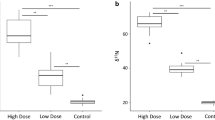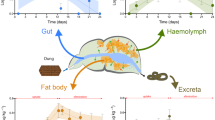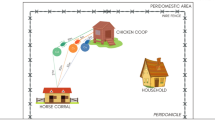Abstract
Radiocesium contaminations in Diptera (Muscidae, Calliphoridae) was investigated at three distances (11 km, 14 km, and 25 km) from the Fukushima Dai-ichi Nuclear Power Plant. The 134+137Cs concentrations in adults of coprophagous Musca hervei Villeneuve and necrophagous Chrysomyia pinguis (Walker) at an 11-km point were 3 and 2.8–4 times higher than those of a 14-km point, respectively. The 134+137Cs concentration in adults C. pinguis throughout three years from 2014 to 2016 with maximum 6886 Bq kg−1 was significantly higher than that of M. hervei. In rearing experiments, eggs of uncontaminated Neomyia cornicina (Fabricius) and Lucilia caesar Linnaeus were inoculated onto cattle dung and meat samples (cattle and the Japanese monkey) contaminated with radiocesium. The 134+137Cs concentrations in pupae of N. cornicina reared from two contamination levels of dung samples were 217 ± 4.9 Bq kg−1 and 597 ± 22 Bq kg−1, respectively; those in pupae of L. caesar reared from two contamination levels of monkey meat samples were 55 ± 4.3 Bq kg−1 and 3390 ± 55 Bq kg−1, respectively. The 134+137Cs concentrations in adults emerged from pupae for cattle dung and meat suggest that most of the 134+137Cs in pupae transfer to adults during metamorphosis in cyclorrhaphous Diptera.



Similar content being viewed by others
References
Akimoto S (2014) Morphological abnormalities in gall-forming aphids in a radiation-contaminated area near Fukushima Daiichi: selective impact of fallout? Ecol Evol 4:355–369
Aoki Y, Suzuki KT (1984) Excretion of cadmium and change in the relative ratio of iso-cadmium-binding proteins during metamorphosis of fleshfly (Sarcophaga peregrina). Comp Biochem Phyiol 78C:315–317
Avery SV (1996) Fate of caesium in the environment: distribution between the abiotic and biotic components of aquatic and terrestrial ecosystems. J Environ Radioact 30:139–171
Ayabe Y, Kanasashi T, Hijii N, Takenaka C (2014) Radiocesium contamination of the web spider Nephila clavata (Nephilidae: Arachnida) 1.5 years after the Fukushima Dai-ichi Nuclear Power Plant accident. J Environ Radioact 127:105–110
Chino M, Nakayama H, Nagai H, Terada H, Katata G, Yamazawa H (2011) Preliminary estimation of release amounts of 131I and 137Cs accidentally discharged from the Fukushima Daiichi nuclear power plant into the atomosphere. J Nucl Sci Technol 48:1129–1134
Copplestone D, Johnson MS, Jones SR, Toal ME, Jackson D (1999) Radionuclide behaviour and transport in a coniferous woodland ecosystem: Vegetation, invertebrates and wood mice, Apodemus sylvaticus. Sci Total Environ 239:95–109
Crossley DA Jr, Howden HF (1961) Insect-vegetation relationships in an area contaminated by radioactive wastes. Ecology 42:302–317
Crossley DA Jr, Pryor ME (1960) The uptake and elimination of cesium-137 by a grasshopper˗Romalea microptera. Health Phys 4:16–20
Crossley DA Jr, Reichle DE (1969) Analysis of transient behavior of radioisotopes in insect food chains. BioSci 19:341–343
DiGregorio D, Kitchings T, Van Voris P (1978) Radionuclide transfer in terrestrial animals. Health Phys 34:3–31
Doi H, Kikuchi E, Takagi S, Shikano S (2007) Changes in carbon and nitrogen stable isotopes of chironomid larvae during growth, starvation and metamorphosis. Rapid Commun Mass Spectromet 21:997–1002
Gulakov AV (2014) Accumulation and distribution of 137Cs and 90Sr in the body of the wild boar (Sus scrofa) found on the territory with radioactive contamination. J Environ Radioact 127:171–175
Harwood RF, James MT (1979) Entomology in human and animal health, 7th edn. Macmillan Publishing Co. Inc., New York
Hasegawa M, Ito MT, Kaneko S, Kiyono Y, Ikeda S, Makino SI (2013) Radioactive concentrations in epigeic earthworms at various distances from the Fukushima Nuclear Power Plant 6 months after the 2011 accident. J Environ Radioact 126:8–13
Hasegawa M, Kaneko S, Ikeda S, Akama A, Komatsu M, Ito MT (2015) Changes in radiocesium concentrations in epigeic earthworm in relation to the organic layer 2.5 years after the 2011 Fukushima Dai-ichi Nuclear Power Plant accident. J Environ Radioact 145:95–101
Hayama S, Nakiri S, Nakanishi S, Ishii N, Ono T, Kato T, Konno F, Kawamoto Y, Tsuchida S, Ochiai K, Omi T (2013) Concentration of radiocesium in the wild Japanese monkey (Macaca fuscata) over the first 15 months after the Fukushima Daiichi nuclear disaster. PLoS ONE 8:e68530
Hayashi T, Watanabe H, Watanabe M, Kobayashi M (2012) Mass occurrence of flies and seasonal changes in their species composition in the Tsunami disaster region after 2011 the Great East Japan earthquake. Med Entomol Zool 63:85–89 (in Japanese with English abstract)
Hiyama A, Nohara C, Kinjo S, TairaW GS, Tanahara A, Otaki JM (2012) The biological impacts of the Fukushima nuclear accident on the pale grass blue butterfly. Sci Rep 2:570
International Atomic Energy Agency (IAEA) (2006) Environmental consequences of the chernobyl accident and their remediation: twenty years of experience. In: Report of the chernobyle forum expert group ‘Environment’. Radiol. Assessment Rep. Ser. IAEA, Vienna, p 166
International Atomic Energy Agency (IAEA) (2009) IAEA-TECDOC-1616, quantification of radionuclide transfer in terrestrial and freshwater environments for radiological assessments. IAEA, Vienna, p 624
Iwasa M, Kabeya H, Nakaya F, Sato K, Ishikawa S, Takahashi T (2020) Radiocesium concentrations in invertebrates and their environmental media at two distances from the Fukushima Dai-ichi Nuclear Power Plant during 3–6 years after the 2011 accident. Environ Pollut 267:115657
Katata G, Ota M, Terada H, Chino M, Nagai H (2012) Atmospheric discharge and dispersion of radionuclides during the Fukushima Dai-ichi Nuclear Power Plant accident. Part 1: source term estimation and local-scale atomospheric dispersion in early phase of the accident. J Environ Radioact 109:103–113
Kraus JM, Walters DM, Wesner JS, Stricker CA, Schmidt TS, Zuellig RE (2014) Metamorphosis alters contaminants and chemical tracers in insects: implications for food webs. Environ Sci Technol 48:10957–10965
Krivolutzkii DA, Pokarzhevskii AD (1992) Effects of radioactive fallout on soil animal populations in the 30 km zone of Chernobyl atomic power station. Sci Total Environ 112:69–77
Maksimova SL (1996) Effects of radioactive contamination caused by Chernobyl nuclear accident on soil invertebrates. Pak J Zool 28:277–281
Mietelski JW, Szwalko P, Tomankiewicz E, Gaca P, Grabowska S (2003) Geotrupine beetles (Coleoptera: Scarabaeoidea) as bio-monitors of man-made radioactivity. J Environ Monit 5:296–301
Mietelski JW, Szwalko P, Tomankiewicz E, Gaca P, Malek S, Barszcz J, Grabowska S (2004) 137Cs, 40K, 90Sr, 238,239+240Pu, 241Am and 243+244 Cm in forest litter and their transfer to some species of insects and plants in boreal forests: Three case studies. J Radioanal Nucl Chem 262:645–660
Mitsuhashi R, Mizuno H, Saeki S, Uchiyama SI, Yoshida M, Takamatsu Y, Fugo H (2013) Radioactive caesium contamination in Inago and sustainability of Inago cuisine in Fukushima. Food Hyg Safety Sci 54:410–414 (in Japanese with English summary)
Murakami M, Ohte N, Suzuki T, Ishii N, Igarashi Y, Tanoi K (2014) Biological proliferation of cesium-137 through the detrital food chain in a forest ecosystem in Japan. Sci Rep 4:3599
Okada K, Sato I, Deguchi Y, Morita S, Yasue T, Yayota M, Takeda K, Sato S (2013) Distribution of radioactive cesium in edible parts of cattle. Anim Sci J 84:798–801
R Development Core Team (2012) R: a Language and Environment for Statistical Computing. R Foundation for Statistical Computing, Vienna. http://www.r-project.org. Accessed 15 Jul 2019
Reichle DE (1967) Radioisotope turnover and energy flow in terrestrial isopod populations. Ecology 48:351–366
Reichle DE, Crossley DA Jr (1965) Radiocesium dispersion in a cryptozoan food web. Health Phys 11:1375–1384
Reichle DE, Van Hook Jr RI (1970) Radionuclide dynamics in insect food chains. Manitoba Entomol 4:22–32
Reichle DE, Dunaway PB, Nelson DJ (1970) Turnover and concentration of radionuclides in food chains. Nucl Safety 11:43–56
Rudge SA, Johnson MS, Leah RT, Jones SR (1993) Biological transport of radiocesium in a semi-natural grassland ecosystem. 1. Soils, vegetation and invertebrates. J Environ Radioact 19:173–198
Sano T (2014) Damage situation and reconstruction measures in Fukushima Prefecture Livestock Industry by the Great East Japan Earthquake. Aichi Prefectural Government (in Japanese). https://www.pref.aichi.jp/uploaded/attachment/42747.pdf. Accessed 21 Oct 2006
Sarica J, Amyot M, Bey J, Hare L (2005) Fate of mercury accumulated by blowflies feeding on fish carcasses. Environ Toxicol Chem 24:526–529
Sato I, Okada K, Sasaki J, Chida H, Satoh H, Miura K, Kikuchi K, Otani K, Sato S (2015) Distribution of radioactive cesium and stable cesium in cattle kept on a highly contaminated area of Fukushima nuclear accident. Anim Sci J 86:716–720
Sato I, Sasaki J, Satoh H, Deguchi Y, Otani K, Okada K (2016) Distribution of radioactive cesium and its seasonal variations in cattle living in the “difficult-to-return zone” of the Fukshima nuclear accident. Anim Sci J 87:607–611
Semizhon T, Putyrskaya V, Zibold G, Klemt E (2009) Time-dependency of the 137Cs contamination of wild boar from a region in Southern Germany in the years 1998 to 2008. J Environ Radioact 100:988–992
Steinhauser G, Saey PRJ (2016) 137Cs in the meat of wild boars: a comparison of the impacts of Chernobyl and Fukushima. J Radioanal Nucl Chem 307:1801–1806
Strebl F, Tataruch F (2007) Time trends (1986–2003) of radiocesium transfer to roe deer and wild boar in two Austrian forest regions. J Environ Radioact 98:137–152
Tabaru Y, Kanno K, Kawabata T, Ishikawa Y, Tanaka K, Hirao M, Kumon K, Watanabe M (2012) Outbreak of blow flies in the tsunami affected areas and their control. Med Entomol Zool 63:71–83 (in Japanese with English abstract)
Tanaka S, Hatakeyama K, Takahashi S, Adati T (2016) Radioactive contamination of arthropods from different trophic levels in hilly and mountainous areas after the Fukushima Daiichi nuclear power plant accident. J Environ Radioact 164:104–112
Tanoi K, Uchida K, Doi C, Nihei N, Hirose A, Kobayashi NI, Sugita R, Nobori T, Nakanishi MT, Kanno M, Wakabayashi I, Ogawa M, Tao Y (2016) Investigation of radiocesium distribution in organs of wild boar grown in Iitate, Fukushima after the Fukushima Daiichi nuclear power plant accident. J Radioanal Nucl Chem 307:741–746
Tibbets TM, Wheeless LA, Martinez del Rio C (2008) Isotopic enrichment without in diet: an ontogenetic shift inδ15N during insect metamorphosis. Funct Ecol 22:109–113
Van Hook Jr RI, Crossley DA Jr (1969) Assimilation and biological turnover of cesium-134, iodine-131, and chromium-51 in brown crickets, Acheta domesticus (L.). Health Phys 16:463–467
Voshell JR Jr, Eldridge JS, Oakes TW (1985) Transfer of 137Cs and 60Co in a waste retention pond with emphasis on aquatic insects. Health Phys 49:777–789
Wesner JS, Walters DM, Schmidt TS, Kraus JM, Stricker CA, Clements WH, Wolf RE (2017) Metamorphosis affects metal concentrations and isotopic signatures in a mayfly (Baetis tricaudatus): implications for the aquatic-terrestrial transfer of metals. Environ Sci Technol 51:2438–2446
Wood MD, Leah RT, Jones SR, Copplestone D (2009) Radionuclide transfer to invertebrates and small mammals in a coastal sand dune ecosystem. Sci Total Environ 407:4062–4074
Yoshimura M, Akama A (2014) Radioactive contamination of aquatic insects in a stream impacted by the Fukushima nuclear power plant accident. Hydrobiologia 722:19–30
Acknowledgements
We wish to express our sincere thanks to Mrs. M. Yoshizawa of Yoshizawa Farm, F. Watanabe of Omaru Kyodo Farm in Namie Town, and Dr. K. Okada of Iwate University for their support during our survey, and the local government of Namie Town for the permission to conduct the survey. We are also grateful to Dr. Y. Urushihara of Institute of Development, Aging and Cancer, Tohoku University for his kindness in offering the valuable meat samples of monkeys. Our thanks are also due to Assoc. Prof. G. A. Hill of Obihiro University of Agriculture and Veterinary Medicine for his checking of the English in this manuscript.
Author information
Authors and Affiliations
Corresponding author
Additional information
Publisher's Note
Springer Nature remains neutral with regard to jurisdictional claims in published maps and institutional affiliations.
Rights and permissions
About this article
Cite this article
Iwasa, M., Sato, K., Ishikawa, Si. et al. Radiocesium contaminations and transfer in cyclorrhaphous flies (Diptera: Muscidae, Calliphoridae) at three distances from the Fukushima Dai-ichi Nuclear Power Plant after the 2011 accident. Appl Entomol Zool 57, 81–91 (2022). https://doi.org/10.1007/s13355-021-00768-0
Received:
Accepted:
Published:
Issue Date:
DOI: https://doi.org/10.1007/s13355-021-00768-0




